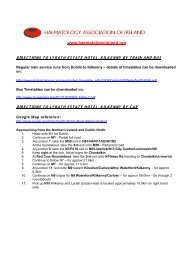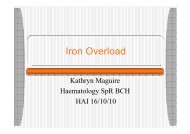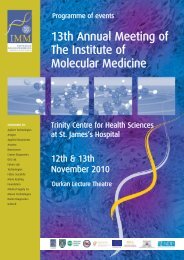Guidelines on Diagnosis and Treatment of Malignant Lymphomas
Guidelines on Diagnosis and Treatment of Malignant Lymphomas
Guidelines on Diagnosis and Treatment of Malignant Lymphomas
You also want an ePaper? Increase the reach of your titles
YUMPU automatically turns print PDFs into web optimized ePapers that Google loves.
Comm<strong>on</strong> Issues in<br />
Lymphoma Management<br />
CNS-DIRECTED THERAPY<br />
CNS-directed therapy is indicated for patients with:<br />
■<br />
■<br />
■<br />
■<br />
Lymphoblastic Lymphoma<br />
Burkitt Lymphoma<br />
HIV-related lymphoma<br />
HTLV-I-related lymphoma<br />
There is no general agreement about a preferred CNS-directed<br />
therapy schedule. The following have been suggested:<br />
■<br />
■<br />
Intrathecal methotrexate (12.5mg) <strong>on</strong>ce<br />
per chemotherapy cycle for 4 – 6 doses.<br />
Cytarabine (50mg) can be substituted for<br />
methotrexate or the liposomal preparati<strong>on</strong><br />
<strong>of</strong> cytarabine can be c<strong>on</strong>sidered.<br />
■<br />
■<br />
Post-transplant lymphomproliferative disease<br />
High risk DLBCL as described below<br />
DLBCL patients with high-risk IPI scores, para-nasal sinus or<br />
testicular involvement <strong>and</strong> marrow involvement are at higher risk<br />
<strong>of</strong> CNS disease, which is associated with poor survival. The<br />
overall risk based <strong>on</strong> high IPI (↑ LDH, marrow involvement) is<br />
around 5%. Where there is involvement <strong>of</strong> sinus or testis the risk<br />
<strong>of</strong> CNS disease is 20 – 50%.<br />
■<br />
Regimens including intermediate or high-dose methotrexate,<br />
high-dose cytarabine <strong>and</strong> ifosfamide also provide effective<br />
CNS-directed therapy.<br />
67
















